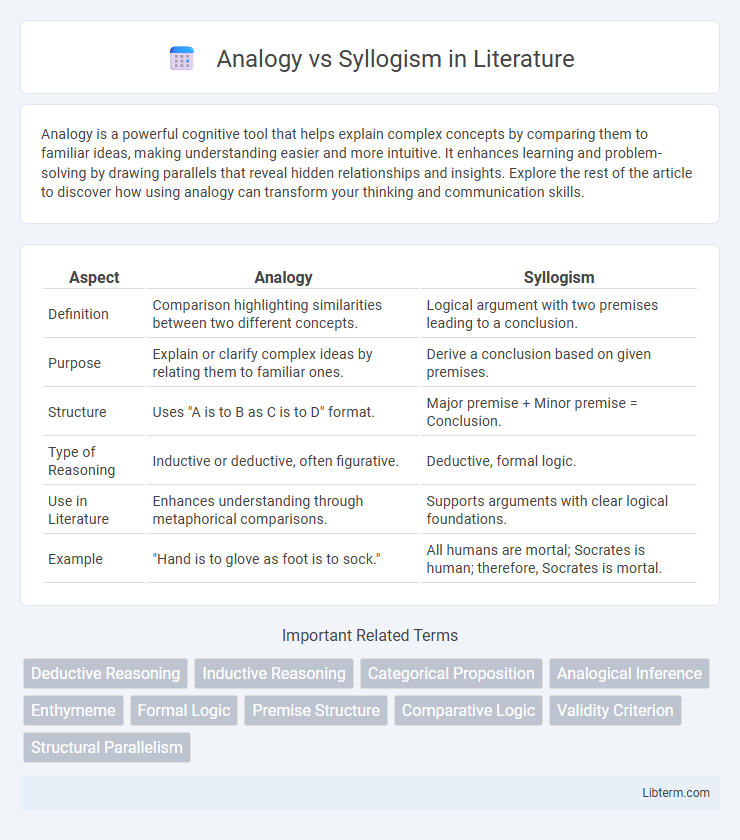Analogy is a powerful cognitive tool that helps explain complex concepts by comparing them to familiar ideas, making understanding easier and more intuitive. It enhances learning and problem-solving by drawing parallels that reveal hidden relationships and insights. Explore the rest of the article to discover how using analogy can transform your thinking and communication skills.
Table of Comparison
| Aspect | Analogy | Syllogism |
|---|---|---|
| Definition | Comparison highlighting similarities between two different concepts. | Logical argument with two premises leading to a conclusion. |
| Purpose | Explain or clarify complex ideas by relating them to familiar ones. | Derive a conclusion based on given premises. |
| Structure | Uses "A is to B as C is to D" format. | Major premise + Minor premise = Conclusion. |
| Type of Reasoning | Inductive or deductive, often figurative. | Deductive, formal logic. |
| Use in Literature | Enhances understanding through metaphorical comparisons. | Supports arguments with clear logical foundations. |
| Example | "Hand is to glove as foot is to sock." | All humans are mortal; Socrates is human; therefore, Socrates is mortal. |
Introduction to Analogy and Syllogism
Analogy and syllogism are key methods of reasoning in logic that help draw conclusions based on relationships and premises. An analogy compares two different things by highlighting similarities, often used to explain or clarify complex concepts. In contrast, a syllogism consists of a structured argument with two premises leading to a logical conclusion, forming the foundation of deductive reasoning.
Defining Analogy: Meaning and Usage
Analogy is a cognitive process that establishes a relationship based on similarity between two different objects or concepts, often used to explain or clarify complex ideas by comparing them to familiar ones. It plays a crucial role in reasoning, learning, and communication by highlighting parallel structures or functions, thereby facilitating understanding and problem-solving. Unlike syllogism, which relies on formal logical deduction through premises leading to a conclusion, analogy emphasizes relational resemblance rather than strict logical inference.
Understanding Syllogism: Structure and Purpose
Syllogism is a form of deductive reasoning consisting of two premises and a conclusion, where the conclusion logically follows from the premises. Its structure includes a major premise, a minor premise, and a conclusion, aiming to establish truth by linking premises through a shared term. Understanding syllogism is essential for analyzing logical arguments and distinguishing valid inferences from fallacies.
Key Differences Between Analogy and Syllogism
Analogy involves drawing a comparison between two different things based on their similarities, often used to explain or clarify concepts, while syllogism is a form of deductive reasoning consisting of a major premise, a minor premise, and a conclusion. Key differences include that analogy relies on similarity and is inductive, whereas syllogism is based on strict logical structure and deductive reasoning. Furthermore, syllogisms provide definitive conclusions when premises are true, while analogies offer suggestive insights that do not guarantee truth.
Types of Analogies in Reasoning
Analogies in reasoning include several types: propositional analogies, which compare relationships between pairs of concepts; literal analogies, where two similar cases are compared to draw conclusions; and functional analogies, highlighting similarities in purpose or function. These analogical types differ from syllogisms, which rely on deductive logic with premises leading to a necessary conclusion. Understanding types of analogies enhances the ability to infer new knowledge by identifying relational patterns rather than solely depending on categorical logic.
Common Forms of Syllogistic Arguments
Syllogisms commonly follow three forms: categorical, hypothetical, and disjunctive, each structured to draw conclusions from premises using logical relationships between categories or conditions. Categorical syllogisms consist of two premises and a conclusion that relate two categories through a middle term, such as "All A are B; all B are C; therefore, all A are C." Hypothetical syllogisms involve conditional ("if-then") statements, and disjunctive syllogisms use "either-or" premises to conclude the truth of one alternative by negating the other, establishing precise logical deductions distinct from analogy-based reasoning.
Strengths and Weaknesses of Analogy
Analogy offers the strength of simplifying complex concepts by drawing parallels between similar situations, making abstract ideas more relatable and easier to understand. However, its weakness lies in the potential for false equivalence, where differences between compared entities may lead to misleading conclusions. Unlike syllogism, which relies on deductive reasoning with explicit premises and valid logical structure, analogy depends on the degree of similarity, making it less rigorous and more subjective.
Strengths and Weaknesses of Syllogism
Syllogism excels in providing a clear, logical structure that ensures conclusions follow necessarily from premises, enhancing the reliability of deductive reasoning. Its main weakness lies in the necessity for premises to be both true and relevant; false or irrelevant premises lead to invalid conclusions, limiting practical applicability in ambiguous or complex real-world contexts. While syllogisms offer rigorous proof in formal arguments, their rigidity can hinder adaptability compared to analogical reasoning, which accommodates probabilistic and intuitive insights.
Practical Applications of Analogy and Syllogism
Analogy is widely used in education and law to simplify complex concepts by drawing parallels, enhancing comprehension and persuasive communication. Syllogism serves as a fundamental tool in formal logic and computer science for constructing and validating deductive arguments systematically. Both reasoning methods support critical thinking, with analogy fostering creative problem-solving and syllogism ensuring rigorous logical consistency.
Conclusion: Choosing the Right Reasoning Method
Analogy draws conclusions by comparing similarities between two different cases, making it ideal for generating hypotheses or explaining complex ideas through relatable examples. Syllogism relies on deductive reasoning with clearly defined premises leading to a logically certain conclusion, suited for formal proofs and rigorous argumentation. Selecting between analogy and syllogism depends on whether the goal is to persuade through relatable reasoning or to establish incontrovertible truth.
Analogy Infographic

 libterm.com
libterm.com